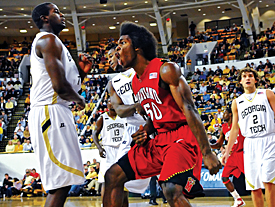
In many ways, Bambale Osby seems larger than life.
His mountainous afro looks like a well-pruned garden hedge, and his facial features and muscles are enormous. But as he sits with his monstrous hands on his knees and tells of his improbable rise to success, the immensity fades away.
When he speaks of his troubled past with incredible candor and frankness, he is no longer the 6-foot-8 fan-favorite big-man who’s turning heads nationwide. Under the massiveness of “Boom” lies a story made up of the complexity of everyday life and the tiny tweaks and turns that paved a dead-end road into a limitless future.
The flight from a dangerous and turbulent childhood in Virginia to an essential role on the Terrapin basketball team made improbable stops in New Mexico, Texas and many other places in between.
But all his perseverance and persistence earned him the right to stand where he does today – as a Division-I college basketball player who has drastically improved his performance on the court with each game, especially in the last month. And his development away from the game is equally inspiring.
Roughing it in Richmond
Osby’s father, William, left his family to fend for itself in the crack-ridden projects of Richmond in the late ’80s. Osby was 3 years old. And while he doesn’t remember much, his distinct recollections paint haunting images of a city that repeatedly ranked among the nations’ most dangerous in the ’90s.
One day, Osby remembers coming home to see his bunk bed disassembled and on the floor of his family’s first-story apartment.
“I didn’t understand why,” he said. “I looked at the window and I was like, ‘Who is throwing rocks at our window?’ But they weren’t rocks – they were bullet holes. So my mom put us on the floor.”
Even when recounting a disturbing memory, Osby’s disposition remains upbeat and unchanged.
“It’s just life,” he said. “It happens.”
It would continue to happen as he grew, only getting worse. In seventh grade, an after-school program intended to help Osby deal with any possible anger from his parents’ separation instead veered the youngster off-course. It interfered with basketball tryouts at his Richmond middle school, and that’s when the Boulevard Knights, an infamous Richmond gang, entered the picture.
“I was pissed, so I stopped going to the program and said, ‘The hell with it.’ I started running with the Knights, and we were bad, man. Breaking into houses, stealing cars, robbing people. I knew it was wrong. But that’s what goes on.”
Then, while still in middle school, some acquaintances of Osby’s and his newfound posse became statistics to add to Richmond’s astronomical murder rate.
“They said, ‘Come on, we got to go kill these people.’ At that point I was like, ‘Look, I can’t be a part of this.'”
As he recounts the end of the opening chapter, the scene he paints feels like that from a movie. The local news the following morning, he said, reported the ramifications of Osby’s decision not to ride with his gangmates – six people were murdered that night.
Trying to change
Osby returned to school, but still found a line of Fs on his report cards, as his mind was elsewhere.
“I couldn’t walk home after school,” he said bluntly. “They’d jump my brother; throw rocks at my house. One time they shot up the back window of my momma’s car. You can’t get out. It’s not that easy. Every day I’d wait around after school when the janitor was cleaning up and locking up at 5 o’clock. I couldn’t walk home.”
The next step in the journey landed Osby in a magnet program at Thomas Jefferson High School in Richmond, where he could get away from his violent past and concentrate on change. After two years of playing basketball and taking French and Spanish, he transferred to a private school, Benedictine High, where he would help his team win two Virginia State Catholic League Championships.
But the transition wasn’t a smooth one.
“Thomas Jefferson was an all-black, urban school,” Osby said. “Benedictine was all boys, all white, Catholic, military. It was scary, dude. The first couple of months I just didn’t talk to anybody. It was something else. The team had probably three black kids [my junior year]. My senior year, it was just me. It was crazy.”
Yet through all the differences, basketball was the universal language. Students knew Osby as the new, giant, friendly kid who averaged more than 16 points and 16 rebounds as a senior, and he began to make friends.
Though not highly recruited, Osby received an offer to play at the University of New Mexico while he was touring with his Amateur Athletic Union team, the Richmond Squires.
Through it all, he had escaped.
College hopping
But again, Osby struggled with change.
He had a great relationship with the assistant coach who recruited him, Duane Broussard, but didn’t get along with head coach Ritchie McKay.
The Lobos went on to win the Mountain West Conference Tournament, but he said his relationship with McKay deteriorated as the season progressed. He averaged just 7.4 minutes per game.
Osby branched out and tried to establish relationships to settle into a life at New Mexico. He had a girlfriend and also a close friend in Marc Tuwiner, 40, the owner of Annapolis Classic Cars. He heard of Tuwiner’s business on the Internet and would contact him about car parts for his Cadillacs. The two quickly became close friends thanks to their common interest in old autos.
Nevertheless, the year was a rough one.
“I didn’t know how to be social,” he said. “I was alone, and it was my first time being away. And I wasn’t real good friends with a lot of guys on the team. That was the hardest part.”
It got so bad that Osby said a teammate overheard McKay telling interested head coaches from around the country, “You don’t want Osby. He’s a jerk.”
New Mexico didn’t renew the scholarship, and so, frustrated, Osby returned to Richmond. There, his former AAU coaches told him that a junior college was the next step. Dozens opened their doors, and a little-known Texas school of about 4,000 students made the best offer.
Osby headed to Paris Junior College, more focused than ever.
He lived in the gym as he pushed toward success, but again, couldn’t see eye-to-eye with the man in charge, head coach Bill Foy.
“My coach hated me, I’m not even lying,” Osby said with a chuckle. “He told the guards on the team not to pass me the ball on top of the key, not to pass me the ball in transition, not to pass it to me if I’m on the block. The same thing started to happen. I was riding the bench, but for some reason or another I would still let the coach get to me instead of just playing.”
Foy, who is now the head coach at the University of North Texas, said Osby improved as the season progressed. But Foy was quick to admit that he and Osby didn’t quite get along.
“We didn’t have a great relationship at first because I didn’t think he was doing the things we needed him to do,” Foy said. “But eventually, he started to do what we asked. And once he started doing that, everything started working out for the betterment of everybody.”
The reasons behind the rocky relationships, however are beyond Osby’s comprehension. And Terrapin head coach Gary Williams doesn’t get it either.
“I don’t really care what went on where he was before,” Williams said. “I just know how he is here. He’s a great guy to coach. He comes and he gives you everything he has. I’ve never had a problem with him in terms of his work ethic, what he does academically, how he is off the court or anything like that. I’m just glad he’s here.”
After the conference all-star game, schools began to recognize Osby’s potential. Scouts from George Washington, Tulane, Rhode Island, Dayton and Marshall all came knocking.
Oh, and the Terrapin coaching staff heard the Boom, as well.
Moving to Maryland
Osby’s demeanor lights up even more than usual when he recounts the preliminary stages of the Terps’ recruiting efforts.
“I thought it was a joke,” he said. “I had an old cell phone, and it was kind of fuzzy. So I called my brother and played him the message. He said, ‘Man, that’s Maryland.’ I said, ‘No way.’ He said, ‘You better call them back.'”
Osby did call back, and it wasn’t joke.
Then-Terrapin assistant coach Rob Moxley had been sent on recruiting ventures to find an inside man, and Osby caught his eye.
But when Osby came to show off his stuff, it was he who dictated the terms of the initial skills showcase. He asked to play against some true Terp talent to gauge his ability.
“If your guys kick my ass and throw me out the gym, I don’t want to play here,” Osby told the coaching staff.
So he squared off against former Terp Ekene Ibekwe, who at 6-foot-9 and with experience to boot was no easy task. But the newcomer fared quite well, and Osby said he remembers distinctly what an assistant coach said after the clash: “I’ve never seen Ekene struggle to score like that.”
Osby was a Terp.
The rest of his story is more well-known, but no less remarkable. Osby helped the Terps to an NCAA Tournament berth last spring, averaging just over 13 minutes a game in his 34 appearances. But with a strong core of seniors on last season’s squad, he wasn’t expected to be as crucial an element in the team’s success.
This season, though, as one of two senior starters, all that has changed.
“This year, I was coming in saying, this is my team, and I’ve got to be a leader and we’ve got to do well,” he said. “That was a lot of pressure.”
In fact, too much pressure, Osby said. The weight of the expectations led to poor play in the season’s initial months and, subsequently, to the Terps’ lethargic start.
But, as always with Osby, the growth continued.
“Boom has always been capable,” said fellow Terp giant James Gist, the team’s other senior starter. “Even last year, I think it was more of a confidence issue than he not being a good player. When he’s in his groove, it’s hard to stop him.”
Anyone watching Osby’s explosion in 2008 is undoubtedly in agreement.
It’s Williams praising Osby’s play after each solid outing. It’s Duke forward Gerald Henderson remarking last week at how much Osby has improved since the teams met last season. It’s ESPN analysts Brad Nessler and Jimmy Dykes repeatedly lauding Osby’s heart and hard work on national television. And, of course, it’s Terp fans realizing that they’ve found something special.
“When Boom walks in the room, everybody knows it’s Boom and he doesn’t have to say a word,” Gist said. “That’s just how you describe Boom. He’s a presence in his own. When he’s not on the court you know Boom’s not on the court. When he comes on the court, everybody knows Boom’s on the court. What you see is what you get with Boom.”
As Osby’s confidence soars, his maturing mindset solidifies and his fame around the country continues to expand. But even when he stood out in a crowd at Poolesville Day with Tuwiner and his five children in their hometown of Poolesville, Md., he’s still just Boom.
“I don’t think it’s changed him at all,” Tuwiner said of Osby’s newfound fame. “He’s not that kind of person. He doesn’t think that just being a player gives him any right. He wants to prove himself. He doesn’t think he’s guaranteed anything in life. Whatever happens to him will be the best thing to happen to him.”
It’s been a long, arduous journey with countless stops along the way, and Osby is nowhere near his final destination. It could be the NBA; it could be a Cadillac parts store that he wants to open with James Mosher, a friend from New Mexico; or it could be something entirely different.
Whatever it is, though, people will always hear of the little changes, the little stories and the little memories of what happened as the big man grew.
They’ll always hear the Boom.
gbassdbk@gmail.com



